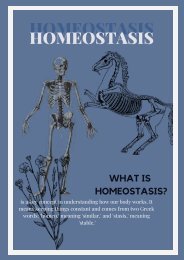HOM (1)
You also want an ePaper? Increase the reach of your titles
YUMPU automatically turns print PDFs into web optimized ePapers that Google loves.
M A I N<br />
C H A R C T E R I S T I C S<br />
O F A N I M A L S<br />
There are four main characteristics that are<br />
used to classify animals: symmetry, body<br />
cavity, tissue, and vertebral column.<br />
The first<br />
characteristic is<br />
symmetry. Animals<br />
generally fall into<br />
two categories - they<br />
either have radial or<br />
bilateral<br />
symmetry. Organis<br />
ms like sea stars<br />
have radial<br />
symmetry, while<br />
organisms such as<br />
humans have<br />
bilateral symmetry<br />
The next thing is<br />
body tissue. The<br />
more complex an<br />
organism is, the<br />
more distinctive<br />
layers of tissue it has.<br />
There are three<br />
main layers:<br />
Ectoderm - the<br />
outermost layer<br />
Endoderm - the<br />
innermost layer<br />
Mesoderm - the<br />
middle layer<br />
As for vertebral<br />
column, there are<br />
two key groups:<br />
invertebrates and<br />
vertebrates. Inverteb<br />
rates are animals<br />
without a backbone,<br />
while vertebrates are<br />
animals with a<br />
backbone. As we<br />
look at the evolution<br />
of animals, we will<br />
first look at the more<br />
simple invertebrates<br />
and then consider<br />
the more complex<br />
vertebrates.




